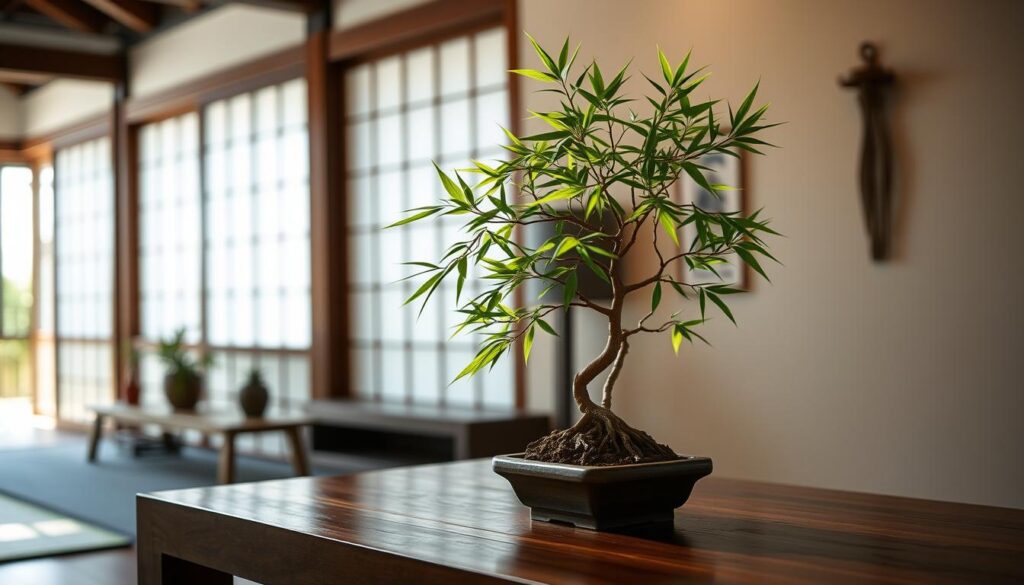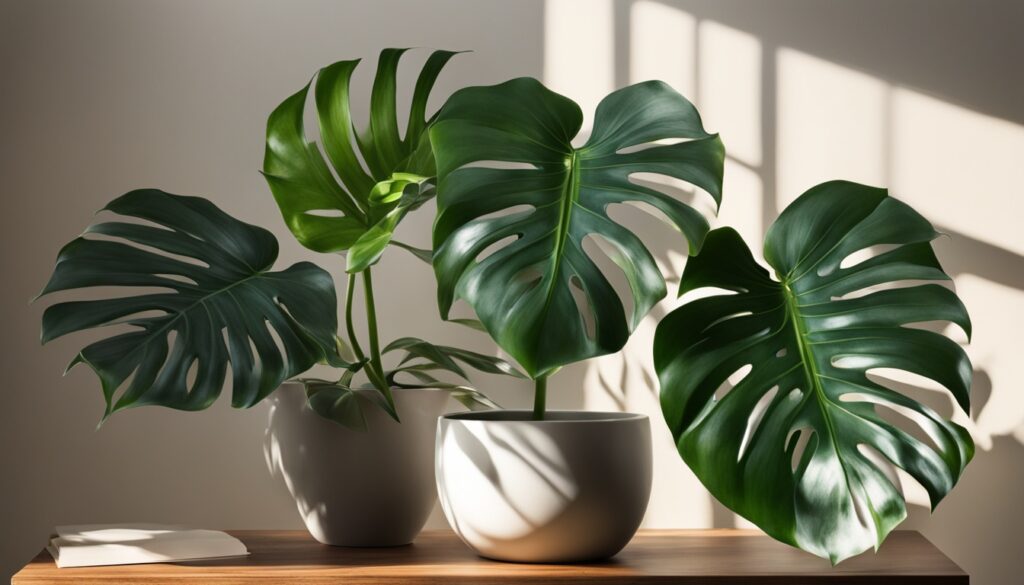Imagine a peaceful spot in your home, filled with the beauty of miniature bamboo plants. These plants bring the calm of ancient Japanese gardens right to you. The bonsai bamboo plant is a mix of nature and art, turning any room into a Zen oasis. But what makes these small, carefully grown plants so special? Discover the captivating world of bonsai bamboo and learn how to create your own Zen garden at home.
Key Takeaways
- Bonsai bamboo plants combine the ancient art of Japanese gardening with modern indoor decor
- These miniature trees require specialized care and techniques to thrive in a home environment
- Proper lighting, watering, and soil conditions are essential for maintaining the health and aesthetics of bonsai bamboo
- Pruning and shaping techniques allow you to create unique, sculptural forms that embody the principles of Zen
- Incorporating bonsai bamboo into your home decor can transform any space into a serene, nature-inspired oasis
Understanding Bonsai Bamboo Plants
The art of bonsai has been around for ages, blending with the Zen horticultural tradition. It’s known for capturing nature’s essence in small forms. Among these, the bonsai bamboo plant is unique and fascinating. Despite being one of the fastest-growing plants, bamboo is perfect for bonsai due to its toughness and flexibility.
History and Cultural Significance
Bonsai bamboo’s history goes back to ancient Asian cultures. It was seen as a symbol of strength, flexibility, and the balance between nature and humans. In Japan, China, and other Asian countries, bonsai bamboo is still practiced today. It has become a detailed and beautiful form of ancient botanical art.
Types of Bamboo Suitable for Bonsai
There are over 1,000 bamboo species worldwide. Choosing the right one for bonsai is key. Dwarf bamboo types like Bambusa ventricosa, Bambusa multiplex, Pleioblastus fortunei, and Pseudosasa owatarii are best for bonsai. They grow compactly, making them ideal for the small spaces and careful care needed for bonsai.
Botanical Characteristics
Bamboo bonsai plants have special features that make them different from other bonsai trees. They don’t have true branches, limiting styling options. But, this challenge has led to creative ways of planting, like mimicking bamboo forests. Bamboo is also great for beginners because it’s more resilient and easier to care for than other plants.
Essential Tools and Materials for Bonsai Creation
Starting a bonsai bamboo plant journey needs the right tools and materials. You’ll need special pruning tools, the right soil, and potting materials. Each one is key to shaping your bonsai.
Pruning Tools and Equipment
Pruning is at the heart of bonsai care. Get high-quality shears, pliers, and concave cutters for precise shaping. While Japanese tools are famous, Chinese ones can be a great value. Look for stainless steel for durability and to avoid rust.
- Bonsai shears and pliers in various sizes to cater to different pruning needs
- Concave cutters for achieving deepened, healing cuts on branches
- Saws for cutting thicker branches, trunks, and roots
- Specialized tools like sickle knives and root hooks for transplanting and root work
Soil and Potting Materials
Good soil is essential for a healthy bonsai. Mix akadama, pumice, and organic matter for a nutrient-rich soil. Use a stainless steel sieve to sift the perfect soil particles.
Container Selection Guide
Choosing the right bonsai container is important. It affects the plant’s look and growth. Pick pots that match your bamboo’s size and species. Make sure they have holes for drainage to avoid waterlogging.
| Bamboo Species | Recommended Pot Size |
|---|---|
| Dwarf Bamboo | 4-6 inches in diameter |
| Larger Bamboo Varieties | 6-8 inches in diameter |
With the right tools and materials, you’re ready to create your own bonsai bamboo plant. It will be a thriving part of your miniature Zen landscape.

Creating Your Miniature Zen Landscape
Making a dwarfed landscape for your home or office is fun and rewarding. Zen gardens bring peace from nature into your space through ornamental cultivation. With the right design and planning, a small area can become a peaceful oasis.
Design Principles and Aesthetics
A Zen garden is all about simplicity. Focus on creating a balanced look that reflects Zen’s principles. Use natural elements like sand, rocks, and plants to bring the outdoors in.
Space Planning and Arrangement
Planning is key for your Zen landscape. Think about the space you have and arrange things for balance and harmony. Try out different layouts, using empty space and placing elements to guide the eye. The goal is to create calm, not chaos.
| Zen Garden Element | Purpose |
|---|---|
| Sand | Represents water and tranquility |
| Rocks | Symbolize mountains and stability |
| Moss | Adds a natural, calming presence |
| Bamboo | Provides a natural fencing and visual interest |
| Miniature Figurines | Can be used sparingly to enhance the overall aesthetic |
“A Zen garden is a powerful tool for cultivating inner peace and harmony.”
By following Zen design and arranging your landscape well, you can make a peaceful oasis. This oasis invites calm and reflection into your daily life.
Proper Watering Techniques for Bonsai Bamboo Plant
Keeping your bonsai bamboo plant healthy means getting the watering right. As indoor plant care and woody plants like bonsai need specific water care, knowing what affects their moisture is key.
Bamboo bonsai plants love to stay moist because they grow fast and need lots of water. How often you water depends on the plant’s spot, soil, pot size, and the weather.
- Check the soil by sticking your finger in it about half an inch deep. If it feels cool and moist, it’s good. But if it’s warm and dry, it’s time to water.
- Water by fully submerging the pot in water until bubbles show up in the soil. This means the roots are well-watered.
- Let the soil dry a bit before watering again, usually every 15-20 minutes. This helps the roots breathe and avoids too much water.
Don’t forget, good drainage is as important as watering often. Make sure your bonsai pot has enough holes to let water drain. This stops water from sitting and causing root rot. Change your watering schedule with the seasons to keep your bamboo bonsai happy.
| Watering Tips for Bonsai Bamboo | Recommendation |
|---|---|
| Watering Frequency | Keep soil moist at all times, adjust schedule as needed |
| Watering Method | Immersion method: submerge entire pot until bubbles appear |
| Drainage | Ensure adequate drainage holes to prevent waterlogging |
| Monitoring | Check soil moisture by inserting finger 1/2 inch into substrate |
By using these watering tips, your bonsai bamboo will flourish. It will keep its lively, small Zen look in your home.
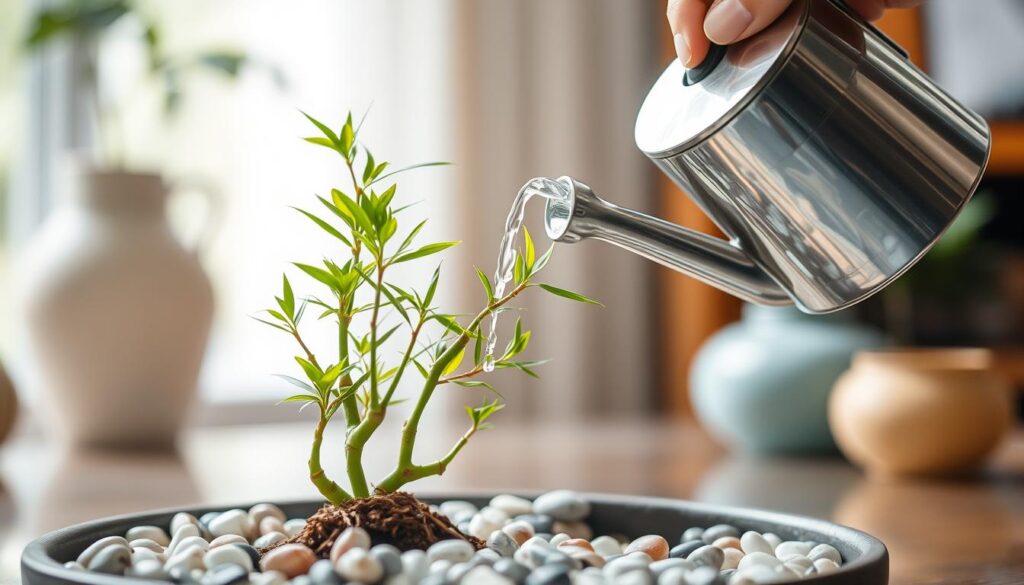
“Watering a bonsai is an art, requiring patience, observation, and a deep understanding of the plant’s needs.”
Light Requirements and Positioning
Lighting is key for your bonsai bamboo plant’s health and growth. They love bright, indirect sunlight, making them perfect for indoor potted greenery. But, direct sunlight can harm their leaves and cause problems.
Natural vs Artificial Lighting
For natural light, place your bonsai bamboo near a window. If sunlight is scarce, use LED grow lights. They’re energy-saving and offer the right light for your indoor plant care.
Seasonal Light Adjustments
- In spring and summer, give your bonsai bamboo 12-15 hours of bright, indirect light daily.
- Adjust light in fall and winter to 9-12 hours.
- Watch your plant’s growth and leaf color to ensure it gets the right light all year.
| Light Requirement | Ideal Lux Range | Optimal Daily Exposure |
|---|---|---|
| Temperate Climate Plants | 700 lux | 9 hours |
| Subtropical Plants | 1,000 – 2,500 lux | 12 – 15 hours |
| Tropical Plants | 1,500 – 5,000 lux | 12 – 15 hours |
Soil Composition and Fertilization Guidelines
Keeping the right soil mix and fertilizing correctly is key for ornamental cultivation of woody plants like bonsai bamboo. The soil’s composition and nutrient balance greatly affect your bonsai’s health and growth.
Optimal Soil Blend for Bonsai Bamboo
Bonsai lovers often use special soils to create the perfect growing medium. Akadama, a porous clay soil, is a favorite. It’s mixed with pumice, lava rock, and keto black peat clay to improve drainage, aeration, and moisture.
| Soil Component | Proportion | Benefits |
|---|---|---|
| Akadama | 70% | Excellent water and air permeability |
| Pumice | 20% | Prevents soil compaction and supports root growth |
| Keto Black Peat Clay | 10% | Enhances water retention in the soil |
Balanced Fertilization for Bonsai Bamboo
The N-P-K ratio is important for bonsai fertilization. A 20-9-9 mix is often suggested, given every 1-2 months in the growing season. Don’t fertilize in winter or when the soil is dry to avoid harming the plant.
“Bonsai plants typically require watering every few days to keep moist, and lucky bamboo plants should have at least a few inches of water from the base of the stalks.”
For newbies, start with a balanced fertilizer to ensure the plant’s health. Then, try specialized fertilizers for specific growth needs, like root growth or foliage.
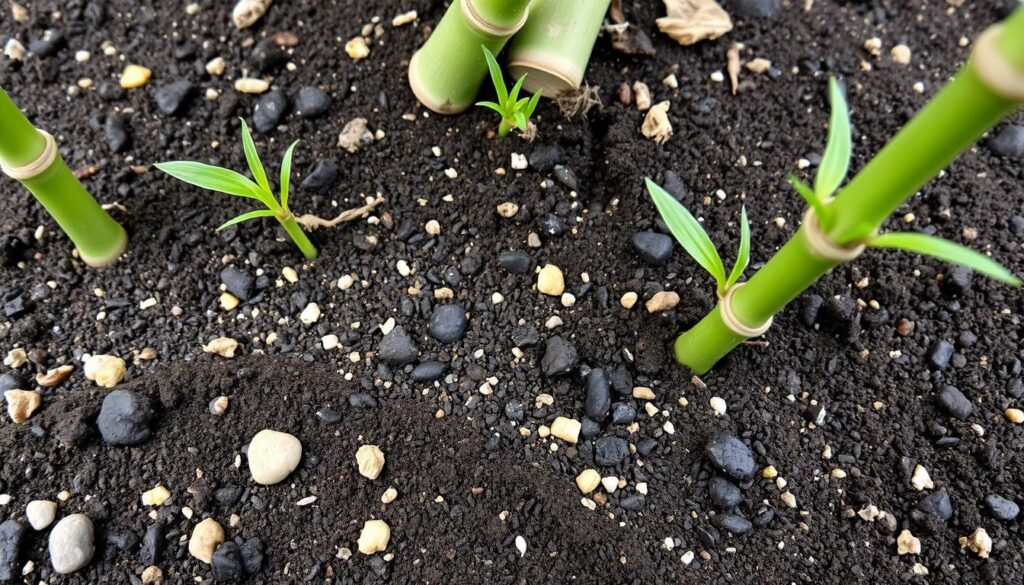
Pruning and Shaping Techniques
Learning to prune and shape is key for creating beautiful dwarfed landscapes and keeping the ancient botanical art of bonsai alive. These skills help manage branch growth and keep roots healthy. They are the basics for making stunning miniature trees that bring peace and calm.
Branch Management
Managing branches is vital for your bonsai’s look and balance. Prune your bonsai twice a year to control bamboo growth and prevent it from getting too big. Remove a quarter of the bamboo culms to the ground and trim others to show off their colors.
Don’t cut bamboo halfway, as it can cause unwanted side growth. Instead, make clean cuts at the base or along the branch. This encourages healthy and beautiful growth.
Root Pruning Basics
- Regularly check your bonsai’s roots and prune any that are too long or tangled.
- Use sharp bonsai pruning tools to make precise cuts and avoid harming the plant.
- Watch the root-to-soil ratio to make sure the roots fit in the container.
- Include root pruning in your seasonal care to keep your bonsai healthy and in shape.
| Pruning Tool | Description | Recommended Use |
|---|---|---|
| Bonsai Pruning Scissors | Sharp, precision-crafted scissors designed for delicate bonsai trimming | Maintain branch and foliage shape |
| Bonsai Wire Set | Flexible wires used to guide and shape branch growth | Manipulate branch and trunk direction |
| Grafting Knife | Sharp, narrow blade for precise grafting techniques | Integrate new features and growth onto bonsai plants |
| Leaf Cutter | Specialized tool for trimming and shaping bonsai foliage | Maintain compact, manicured leaf appearance |
“The most common technique used in bonsai tree care is pruning. It’s essential for maintaining the desired shape and promoting healthy growth.”
Common Pests and Disease Prevention
Keeping your bonsai bamboo plants healthy is key for their long life and growth. These plants are tough but can get sick if not cared for right. Knowing the problems and how to stop them helps keep your plants thriving and your space peaceful.
Identifying and Combating Common Pests
Whiteflies are a big problem for bonsai bamboo. They make leaves turn yellow and slow growth. If not treated, they can kill the plant. Mealybugs attack weak plants, especially in late summer and fall. Passion vine hoppers leave white tufts on stems, which you can stop by removing host plants or pruning.
Aphids can be fought with water or a soap/oil mix. Scale insects build caps and suck sap. Use organic mineral oil to fight scale.
Preventing Pest Infestations
- Check your bonsai bamboo often for pests or diseases like yellow leaves, webs, or growths.
- Water and feed your plant right to keep it strong against pests.
- Make sure your bonsai gets enough light to grow well and fight off pests.
- Try organic pest control like insecticidal soaps or neem oil to keep pests away.
By caring for your plants, treating problems fast, and using prevention, you can keep your woody plants healthy. This keeps your indoor plant care looking great.
| Pest | Symptoms | Control Methods |
|---|---|---|
| Whiteflies | Yellowing leaves, stunted growth | Insecticidal soaps, neem oil |
| Mealybugs | Cottony masses on stems and leaves | Removing infested parts, organic oils |
| Passion Vine Hoppers | White tufts on stems | Removing host plants, pruning |
| Aphids | Leaf curling, stunted growth | Spraying with water, insecticidal soaps |
| Scale Insects | Protective caps on stems and leaves | Organic mineral oil sprays |
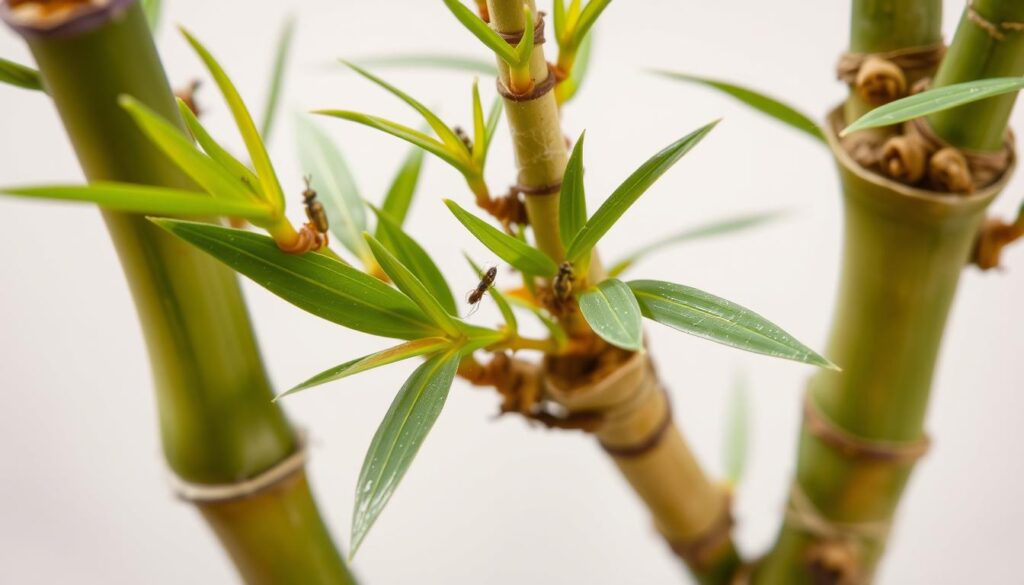
“Regular inspection and proactive pest management are essential for maintaining the health and longevity of your bonsai bamboo plants.”
Seasonal Care and Maintenance Schedule
Keeping your bonsai bamboo plant healthy and long-lasting needs a good seasonal care plan. This is part of the Japanese gardening and Zen horticultural tradition. These small wonders need careful care all year round.
Winter Protection Methods
In the cold months, your bonsai bamboo needs extra care. Make sure it’s away from cold drafts. If it gets too cold, move it inside where it’s warmer.
Wrap the pot in insulation or burlap to keep it warm. Also, don’t let the soil freeze.
Summer Care Routines
In the hot months, your bonsai bamboo needs more water. Water it often to keep the soil moist but not too wet. Give it plenty of indirect sunlight but protect it from the strong sun.
| Season | Care Routine |
|---|---|
| Winter |
|
| Summer |
|
By sticking to these seasonal care tips, your bonsai bamboo will flourish. It will add beauty to your Japanese gardening and Zen horticultural tradition-inspired space.
Propagation Methods for Bamboo Bonsai
Growers have many ways to propagate miniature trees like bamboo bonsai. Seeds can be hard to find, but division and layering are the best methods. These ornamental cultivation wonders thrive with these techniques.
Division and Rhizome Cuttings
Division is a common way to grow bamboo bonsai. It involves splitting the parent plant into smaller parts. Each part should have its own roots for the best chance of growth.
When you divide rhizome shoots, cut off more than one stem. This increases the chances of new plants growing well.
Layering Techniques
- Layering is a favorite for bamboo bonsai. It’s easy to do and needs little care, except to keep the plant moist.
- Air layering, used for trees, also works for bamboo bonsai. But, success depends on the method and care given.
| Propagation Method | Success Rate | Difficulty Level |
|---|---|---|
| Division | High | Moderate |
| Layering | Moderate to High | Low to Moderate |
| Air Layering | Moderate | Moderate to High |
Learning these methods lets bonsai fans grow more trees. They can share their love for ornamental cultivation with others.
“The art of bonsai is not just about growing miniature trees, but about creating living sculptures that capture the essence of nature.”
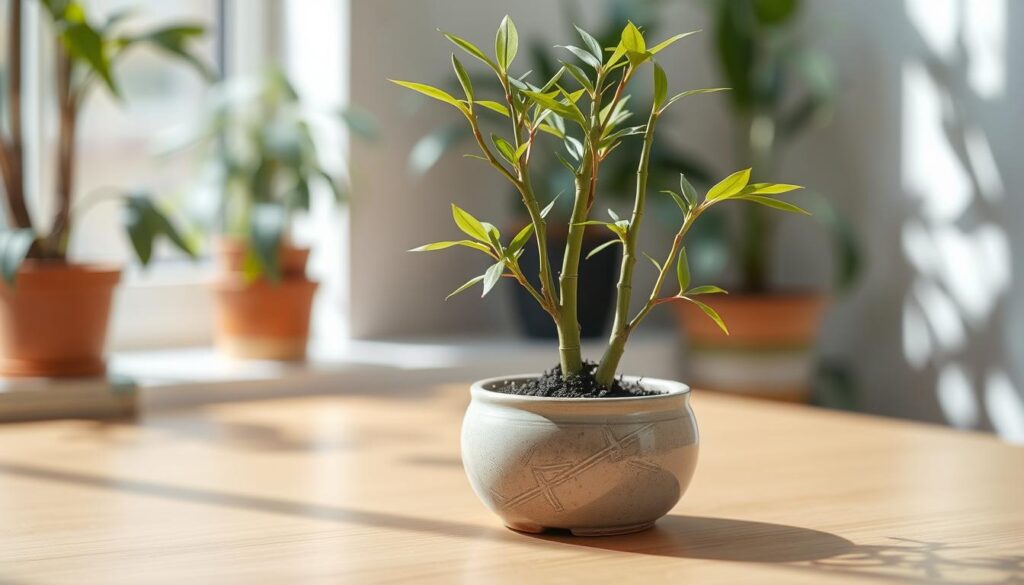
Incorporating Zen Elements and Accessories
Creating a Zen-inspired landscape is more than just growing a bonsai plant. It’s about adding elements that bring peace and connect us with nature. Decorative stones, sand patterns, and small ornaments can turn your garden into a calm oasis.
Decorative Stones and Sand
Rocks and gravel are key in a Zen garden. Big stones show nature’s strength and are placed to balance the space. Sand or gravel patterns look like water, encouraging visitors to think deeply.
Neutral colors like white or gray help keep the garden simple and peaceful. This look is central to Japanese gardening.
Miniature Ornaments
Small ornaments can make your garden more interesting. Things like statues or lanterns add beauty without making it too busy. Bamboo, for example, stands for flexibility and fits well with Zen.
Succulents, ferns, and moss add softness and calm. These elements help make your garden a place for peace and thought.
With these Zen elements, you can make a beautiful, peaceful garden. It’s a place where you can find calm, right in your home.
Troubleshooting Growth Issues
Keeping your indoor bamboo bonsai healthy and growing well can be tricky. But, with careful observation and quick action, you can fix common problems. This way, your bonsai will stay vibrant and strong.
Yellow or brown leaves are a common issue. They might be caused by too much water, too much sun, or not enough nutrients. Fixing this often means changing how you water, giving it the right amount of light, and using a fertilizer that’s good for nitrogen.
Stunted growth or no new canes can also be a problem. Make sure it gets enough sunlight, water it regularly, and trim the canes to encourage new growth. Also, check the soil and repot if needed to help your bonsai thrive.
